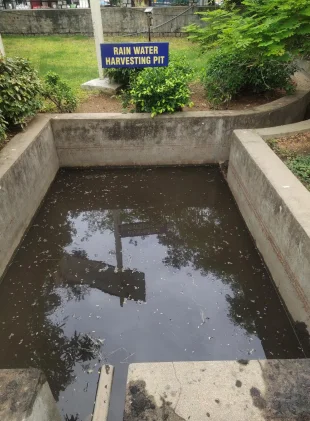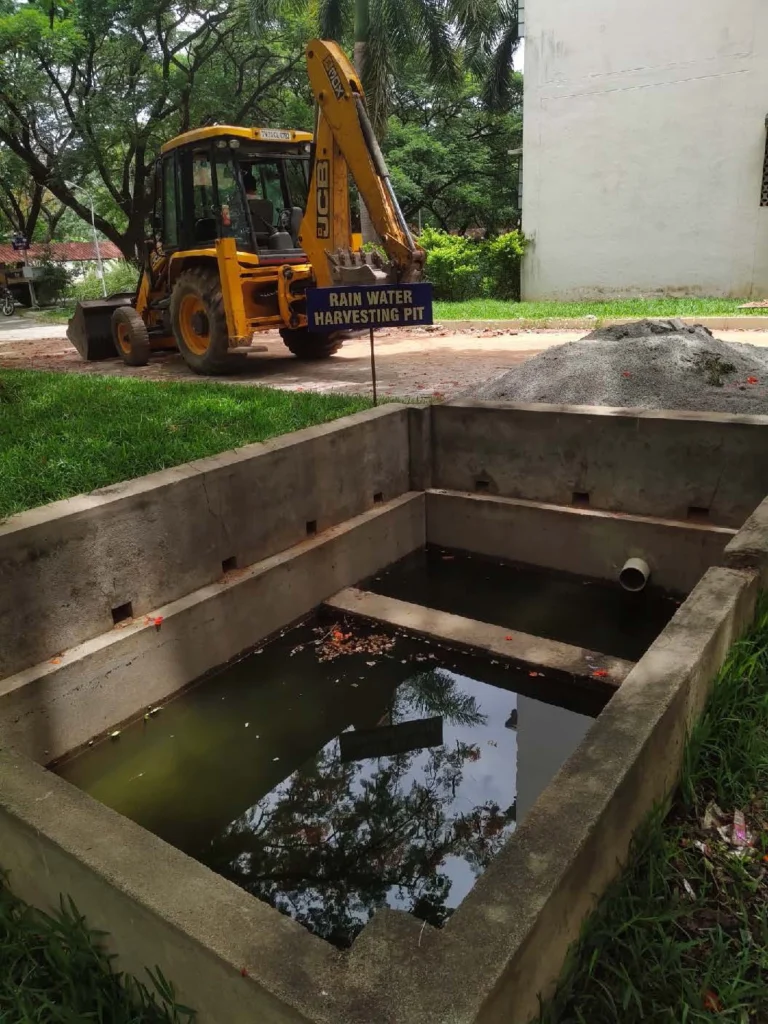Sustainable water extraction on campus
- Home
- sustainability
- Sustainability Initiatives 2022 - 2023
- Sustainable water extraction on campus
VIT is focussed in recharging the water sources through effective rain water harvesting. The presence of natural lake also facilitates the institution in this effort. The rain water harvesting system has the following components
- Campus wise layout for rain water harvesting and recharge – including well maintained water canal system
- Well maintained changing pits around all bore wells
- Protected waterbodies
- Aeration facilities in the lake
- VIT is implementing many strategies to conserve water and ensure the best hygiene practices for all the residents and visitors.
Rainwater Harvesting
Extensive campus-wide rainwater harvesting through broad coverage of lined canals to receive and convey the rainwater from all the locations to a rainwater harvesting pit which can then be utilized in the lean period works well for a hot city like Vellore and benefits the highly populated zone of VIT in many folds.

Lined canal used to reduce water loss and to improve water flow
The concept of sponge city
The VIT Campus in Vellore is well renowned for its all-round green cover. The sponge city concept which favours the runoff management in hilly terrains is applied here to recharge the ground water table instead of maintaining the concrete structures and pavements everywhere. The campus is maintained to have proper built-up to green space ratio allowing the sufficient rainwater percolation during rainy season.

Natural drainage for surface water
Recharge pits and reservoirs
After thorough terrain analysis, the low-lying regions were identified to be the recharge zone and the required water recharge pits/reservoirs were built to improve the ground water table in the vicinity of the campus

Rainwater harvesting pit
Well-maintained lake
VIT has a water body within the campus, which acts as a buffer zone of freshwater. The maintenance of the water body is done with utmost priority. Stabilization of soil and plantation of native species along with the edge of the lake was done for shoreline protection. The lake water quality is regularly monitored to ensure a healthy environment for aquatic species.

Lake
Vellore City receives rainfall during North-East Monsoon (Oct – Dec) and South-West Monsoon (June
– September). A major portion of the rainfall is during North-East Monsoon. Sometimes the city also
receives rainfall during January and February, but that is quite rare.
The annual rainfall in Vellore is in the range of 800- 900 mm. In Metropolitan cities like Vellore, and
outer stretch of the due to the fast rate of urbanization, the city has become a concrete jungle and it
is very difficult to find open surfaces which would enhance the recharge of ground water. Even the
open space left is paved with concrete or bitumen which does not allow the natural recharge of
ground water. This highlights the need to implement measures to ensure that the rain falling over a
region is tapped as fully as possible through appropriate water harvesting techniques for recharging
the ground water aquifers as well as for direct storage and use of rainwater.
1. Rain harvesting system
Keeping in mind the importance of water and it scarcity it is implemented to conserve water by rainwater harvesting by which the subsoil water condition / moisture content is maintained / improved to a great extent. And the rainwater collected from open paved and landscape area is being collected in the storm water drain which is connected to recharging pit.
2. Details of Rain Water Harvesting Pit
The rain harvest pits of suitable size are constructed along the rainwater collection drain. The rain
harvest pit consists of 1.2 diameter borehole for depth of 3 m. Boreholes are made with casing pipes
in position, and then filled up with 10 % of Fine sand and second layer is filled up with 20% of core
sand and third layer is filled with 20 % of 20 mm Jelly stones and fourth layer is filled with 40 mm jelly stones for reaming 50% of area. Taking into consideration the intensity of rainfall in the last 10years, which is considered as 900 mm/year, an effective scheme for rain water disposal has been designed. The run off rain water rooftop is being drained out effectively by providing sufficient number of rain water outlets. These pipes are routed with necessary slope and dropped vertically down to horizontal stack at stilt floor ceiling level .The Rain water pipe has been taken to ground through retaining wall. At ground level through a network of Upvc/RCC hume pipes with suitable diameter and catch basin/saucer drain of suitable sizes for surface catchments, the rain water is finally terminated to the harvesting pit of suitable capacity. Set of Rain water down takes are connected to a Horizontal header on basement ceiling and terminating to Rain water storage tank, where the rain water will be reused for domestic usage after necessary treatment .Overflow water is being pumped to the external rain water drainage system and let into the lake.





